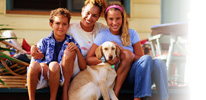


 |
 |
 |
|
||||||||
|
|
How To Perform A Basic Physical On Your Dog Or Cat Important: This segment is for informational purposes only. We strongly recommend regular visits to your veterinarian to ensure your dog or cat stays healthy.This information is NOT intended to replace qualified veterinarians advice or opinions on health issues. By performing this simple exam on your pet on a regular basis you will be more aware of potential problems, and then seek professional assistance sooner, rather than later. We all spend
some quiet time with our pet during the day, so we recommend using this
time to do an brief examination of your pets overall physical condition.
This can be done as your pet is standing up, or laying down. Begin with
a gentle massage of the head, neck, ears and body. Then work your way
down to the tail, legs and feet. This initial massage will help your pet
relax. Speak in a calming manner as you do this. As you massage gently feel for any lumps or bumps on or under the skin, if you find a lump that was not there on your last exam, call your vet and get a professional opinion. As you massage the head, check out the ears. Do you notice any redness on the inner part of the ear flap or in the ear canal ? Do you detect an unpleasant odor, or see any foreign articles or brownish matter in the ear? Go see your vet right away. As you look at your pet’s eyes. Do you notice any redness? Is your pet squinting oris there any discharge from the eyes. Are the lenses clear, or is there whiteness or cloudiness, this may indicate a cataract. Do the eyelids look inflamed, painful, bloodshot with a discharge, this may indicate glaucoma. Schedule a vet visit immediately. Some dog’s can have overactive tear ducts, which is not really that harmful except it may cause skin irritation if left ignored. Usually a wipe of a warm washcloth as needed will clean the tearstain, however you will still want to check it out with your vet, just to be sure. Now pay attention to the nose, is there a nasal drip, a heavy discharge, a greenish (or discolored) mucus, if it persists more than 24 hours see your vet immediately. Now check the mouth area, does the breath smell bad, or worse than normal. This may be tooth decay or worse, it could indicate digestive or even kidney problems. Call your vet for a check up. Are the gums the correct color (ask your vet to show you how to check this). Pale gums could suggest your pet could be anemic. Bluish gum’s could indicate respiratory or cardiac problems. Yellow gum’s could possibly be liver trouble. A healthy pet will have nice pinkish gums and white, clean teeth. Look at the teeth, are they clean or do they have a tartar build up (especially the back ones). Gum disease is common and painful, clean your pets teeth regularly. If they have a tartar build up, book in for a dental work up, your vet will descale the offending teeth and your pet will be so much happier. Check on your pets breathing, constant rapid breathing while at rest may indicate a problem. Ask your vet how to check your pet’s pulse if you are not sure. In dogs, putting your hand inside the left armpit, palm close to the chest is probably the easiest place to get a heartbeat.Now rub your fingers over the head, working down and around the neck area, again checking for lumps or bumps. A quick check to see if your pet is not dehydrated, is to pull up gently on the skin in the neck area (like a momma dog carries her puppies). If the skin falls back in place quickly then your pet is getting enough water. If it is dehydrated, the skin will stay puffed up, and slightly rigid for a time. Call your vet and get his/her advice. During your exam, observe the condition skin and coat, look for rashes, baldness, hot spots and be aware of the presence of parasites, such as fleas or ticks. Fleas especially like the head and hind end regions, because of the moisture present in these areas. When bathing, always put the shampoo on the neck area first, this stops the fleas rushing to the head area. Working down toward the tail, rub your hands around the belly, if it is swollen or potbellied like, you may have an intestinal parasite problem. In an older dog this may indicate fluid build up or even tumors. Have your vet check it out immediately. Follow the entire length of the spine feeling for anything that seems abnormal, swollen areas etc. Check the “private parts” is there any discharge from the penis or vulva, if this is thick and discolored it may indicate an infection. Are there any lumps on the hindquarters or testicles, or change in testicle size? Definitely call your vet, this could be serious. Is your pet lethargic, acting unusual, loosing it’s appetite, eye’s glassy or depressed. Is it vomiting or has it diarrhea. Is it having pain in movement. Is it dragging it’s rear end on the ground. Is it’s breathing shallow, raspy, excessively rapid for no apparent reason. Any of these signs of irregular behavior should send up a red flag, could indicate a serious health problem. Be observant, your pet can’t tell you if it is not feeling well, you need to pay close attention and be more “preventative” in your approach to caring for your pet. Do a basic exam on a weekly basis and if you are not sure about something, have your vet check it out. It’s better to be safe...than sorry. |
|
Copyright © 2003-2005 Pooch School. All rights reserved. |